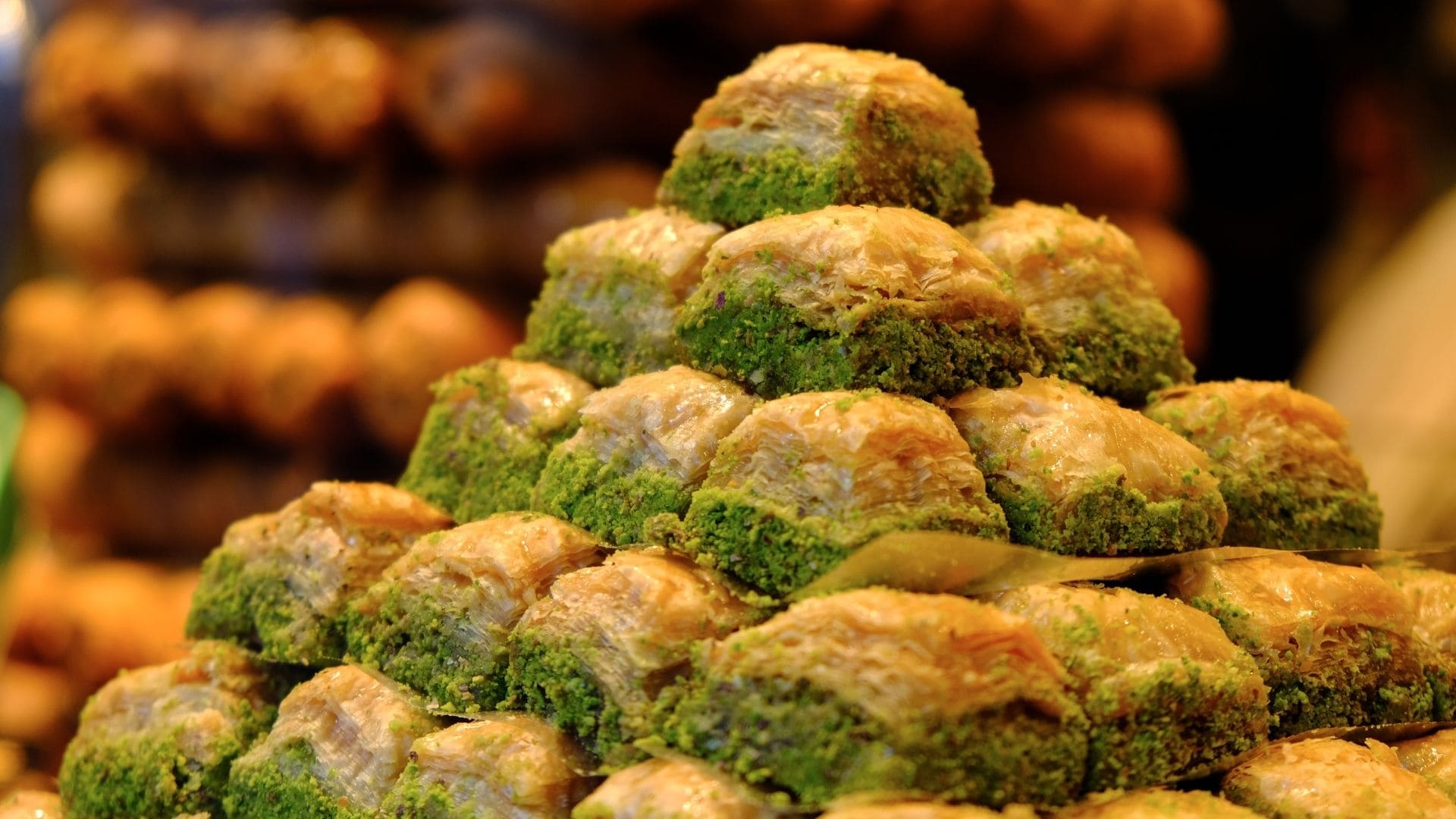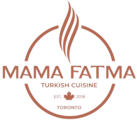Baklava, a rich, sweet pastry made of layers of filo filled with chopped nuts and sweetened with syrup or honey, is one of the most beloved desserts in Turkish cuisine. This delicacy has a long history that spans centuries, evolving through various cultures and regions.
Blog Contents
ToggleAncient Roots of Baklava
The origins of baklava are somewhat debated, with various cultures claiming its invention. However, most historians agree that its roots can be traced back to ancient Mesopotamia. The earliest versions of baklava were made by layering thin sheets of dough with nuts and honey, a practice that was common in the ancient Assyrian and Babylonian cultures.
The recipe spread throughout the Middle East, with each region adding its unique touch. The ancient Greeks, for instance, adopted and adapted the recipe, adding their techniques such as using layers of filo dough, which they called “phyllo,” meaning “leaf” in Greek.
Baklava’s journey continued through the Byzantine Empire, where it became a favored dessert among the elite. Its popularity only grew as it traveled along trade routes, eventually becoming a staple in many Middle Eastern and Mediterranean cuisines.

Ottoman Influence on Baklava
Baklava as we know it today was perfected during the Ottoman Empire. The Ottomans adopted the dish and refined it, creating a sophisticated dessert that was often reserved for the wealthy and served on special occasions. The Topkapi Palace in Istanbul was renowned for its baklava, where it was prepared with great care and served to the sultans and their guests.
The Ottomans also played a crucial role in spreading baklava across their vast empire, which included parts of Europe, Asia, and Africa. This dissemination helped baklava gain popularity and evolve into various regional versions, each with distinct characteristics.
At Mama Fatma Restaurant in Toronto, Ontario, Canada, baklava is made fresh with handmade filo dough, ensuring that each bite is a perfect combination of crispy layers and sweet filling. The restaurant’s baklava recipe closely follows traditional Ottoman methods, giving diners an authentic taste of history.
Characteristics of Baklava Dough
The dough used in baklava, known as filo (or phyllo), is a defining feature of this dessert. Filo dough is incredibly thin and delicate, often compared to paper. It is made from flour, water, and a small amount of oil or vinegar, kneaded into a smooth dough, and then rolled out into thin sheets.
The process of making filo dough is labor-intensive and requires a high level of skill. Each sheet must be thin enough to be almost translucent, yet strong enough to hold the layers of nuts and syrup. This delicate balance is what gives baklava its characteristic texture—crispy, flaky layers that melt in your mouth.
Filo dough’s thinness is achieved through a meticulous rolling process, often done by hand. In traditional settings, rolling pins called “oklava” are used to roll the dough to the desired thinness. This process can take hours, demonstrating the dedication and craftsmanship required to make authentic baklava.
At Mama Fatma Restaurant, the filo dough is made in-house by skilled pastry chefs who have mastered the art of rolling and layering. This dedication to authenticity ensures that each piece of baklava maintains the delicate, flaky texture that is essential to this dessert.

Nuts and Syrups Used in Baklava
The choice of nuts and syrup is another key element that defines baklava. Traditional Turkish baklava is typically made with pistachios or walnuts, though other nuts such as almonds or hazelnuts can also be used. The nuts are finely chopped and layered between the sheets of filo dough, adding a rich, nutty flavor to the dessert.
Pistachios, especially those from the Gaziantep region in Turkey, are highly prized for their quality and flavor. Walnuts, on the other hand, offer a slightly different taste and texture, making them a popular alternative. Regardless of the nut used, they are often lightly toasted to enhance their flavor before being incorporated into the baklava.
The syrup used in baklava is usually made from sugar, water, and lemon juice, with some variations including honey or rosewater. The syrup is poured over the baked baklava, allowing it to soak into the layers and sweeten the pastry. This creates a delightful contrast between the crispy dough and the sweet, sticky syrup.
Imagine enjoying a piece of baklava at Mama Fatma Restaurant, where the nut filling is made from premium Turkish pistachios, and the syrup is infused with a hint of rosewater, giving it a unique and aromatic flavor. The use of high-quality ingredients ensures that each bite is a perfect blend of texture and taste.

Differences in Baklava Interpretation in Modern Kitchens
In modern kitchens, baklava has seen numerous adaptations and innovations. Chefs around the world experiment with different ingredients and techniques to create their unique versions of this classic dessert. Some popular variations include:
- Baklava Cheesecake: Combining the creamy richness of cheesecake with the layers of filo and nuts from baklava.
- Chocolate Baklava: Adding layers of chocolate or cocoa powder to the traditional recipe for a decadent twist.
- Vegan Baklava: Using plant-based butter and agave syrup instead of traditional ingredients to cater to vegan diets.
- Savory Baklava: Incorporating savory ingredients like cheese and herbs to create a unique appetizer or snack.
These modern interpretations allow baklava to be enjoyed in various forms, appealing to a wider audience and catering to diverse dietary preferences.
At Mama Fatma Restaurant, you can find both traditional and modern interpretations of baklava. Whether you prefer the classic version or want to try something new like baklava cheesecake, Mama Fatma offers a delightful experience for all dessert lovers. Their innovative takes on baklava showcase the versatility of this dessert while honoring its rich history.
Cultural Significance of Baklava
Baklava is more than just a dessert; it holds cultural significance in many regions. In Turkey, baklava is often served during special occasions and celebrations, such as weddings, religious festivals, and family gatherings. It symbolizes hospitality and is a way to share joy and tradition with loved ones.
In addition to Turkey, baklava is also an important part of the culinary traditions in Greece, Lebanon, and other Middle Eastern countries. Each culture has its unique spin on the recipe, reflecting local tastes and ingredients. This shared love for baklava highlights the interconnectedness of culinary traditions across the world.
At Mama Fatma Restaurant, the baklava served not only represents a delicious dessert but also a connection to cultural heritage. The restaurant’s ambiance and menu are designed to transport diners to Turkey, offering an authentic experience that celebrates the rich traditions of Turkish cuisine.

Baklava in Popular Culture
Baklava has also made its way into popular culture, appearing in movies, television shows, and literature. Its luxurious and indulgent nature makes it a symbol of celebration and enjoyment. In many Turkish dramas and films, baklava is featured in scenes of family gatherings and festive occasions, highlighting its role in social and cultural life.
The dessert’s popularity has also led to its inclusion in various culinary competitions and cooking shows. Chefs and home cooks alike take pride in their baklava-making skills, showcasing their techniques and creativity.
At Mama Fatma Restaurant, baklava is a star attraction on the menu. Diners often share their experiences on social media, posting photos of the beautifully presented dessert and expressing their delight. This word-of-mouth promotion helps attract more visitors to the restaurant, eager to taste the renowned baklava.


